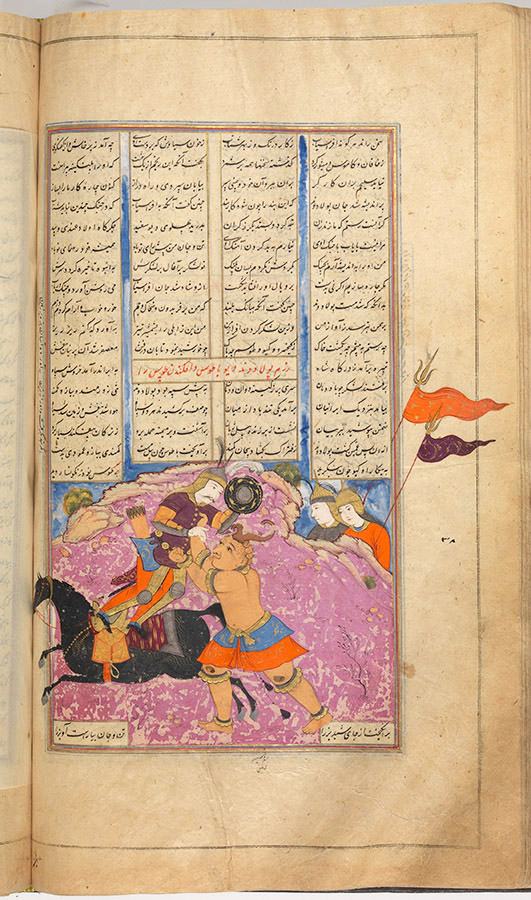Moʿin Moṣavver | Manuscripts | Shahnama of Ferdowsi
Manuscript E, no. 3-257
Pulādvand Lifts Ṭus from His Saddle
Location: The Metropolitan Museum of Art, New York. Acc. no. 1974.290.43
Page: 36.5 x 22.2 cm.
Painting: 11.6 x 14.3 cm (scaled, max. size without narrow extensions between columns or protrusions into margins.)
Text area: 25.2 x 14.3 cm.
Text: four column; deepest column 18 lines on a 30 line per full page matrix.
Illustration number: The number 38 written in Arabic numerals, presumably of later date, appears in the lower right margin, probably indicating that it was the thirty-eighth painting in the manuscript.
The war between Iran and Turān continued for many years, sometimes raging, and other times smoldering. Fearing that his army was no match for the Iranian army presently threatening him, Afrāsiyāb summoned for the assistance of the divs, foremost of whom was Pulādvand. Of enormous strength and skill in combat, Pulādvand defeated one by one all of the famous Iranian warriors who challenged him. Pulādvand first encountered Ṭus like a mad elephant, with mace in hand, seized Tus by the girdle, easily lifted him from the saddle and dashed him to the ground. Next came in turn Giv, Ruhhām, and Bižan; all handily defeated by the div. It was not until the mighty Rostam challenged him, that Pulādvand was finally defeated and fled the field of battle.
The div is illustrated as an ochre colored humanoid with horns, naked except for a short red and blue skirt in the middle of the rather simple composition. Only the two combatants, and two observers are portrayed. True to the text, Pulādvand grabs Ṭus by the waist and lifts him straight off his horse, and is about to dash him to the ground. The confrontation is set against a nondescript mauve colored hillside, rising to a rocky crest at the top of the picture. Some small green shrubs, a pair of observers peering over the crest, and a blue wash sky in the distance complete the scene.
This page is part of the re-bound rump volume known as the "Gutman Shahnama". There are four columns of text above and two single lines of text below the painting. A chapter title is captivated within the two central columns above the painting with a rectangular ruled frame enclosing illustration and text. Two standards and the forequarters of Ṭus's horse violate the frame and protrude into the left and right hand margins. Signed in the center of the lower margin: raqam-e kamina moʿin-e moṣavver.
Painting references:
www.metmuseum.org - search collections for 1974.290.43.
Text references:
Warner, III, p.257. Mohl III, p.257.
Photo: © The Metropolitan Museum of Art, New York. Bequest of Monroe C. Gutman, 1974.
Robert Eng
Last Updated: June 19, 2013 | Originally published: June 19, 2013
Manuscript E, no. 3-257
Pulādvand Lifts Ṭus from His Saddle
Location: The Metropolitan Museum of Art, New York. Acc. no. 1974.290.43
Page: 36.5 x 22.2 cm.
Painting: 11.6 x 14.3 cm (scaled, max. size without narrow extensions between columns or protrusions into margins.)
Text area: 25.2 x 14.3 cm.
Text: four column; deepest column 18 lines on a 30 line per full page matrix.
Illustration number: The number 38 written in Arabic numerals, presumably of later date, appears in the lower right margin, probably indicating that it was the thirty-eighth painting in the manuscript.
The war between Iran and Turān continued for many years, sometimes raging, and other times smoldering. Fearing that his army was no match for the Iranian army presently threatening him, Afrāsiyāb summoned for the assistance of the divs, foremost of whom was Pulādvand. Of enormous strength and skill in combat, Pulādvand defeated one by one all of the famous Iranian warriors who challenged him. Pulādvand first encountered Ṭus like a mad elephant, with mace in hand, seized Tus by the girdle, easily lifted him from the saddle and dashed him to the ground. Next came in turn Giv, Ruhhām, and Bižan; all handily defeated by the div. It was not until the mighty Rostam challenged him, that Pulādvand was finally defeated and fled the field of battle.
The div is illustrated as an ochre colored humanoid with horns, naked except for a short red and blue skirt in the middle of the rather simple composition. Only the two combatants, and two observers are portrayed. True to the text, Pulādvand grabs Ṭus by the waist and lifts him straight off his horse, and is about to dash him to the ground. The confrontation is set against a nondescript mauve colored hillside, rising to a rocky crest at the top of the picture. Some small green shrubs, a pair of observers peering over the crest, and a blue wash sky in the distance complete the scene.
This page is part of the re-bound rump volume known as the "Gutman Shahnama". There are four columns of text above and two single lines of text below the painting. A chapter title is captivated within the two central columns above the painting with a rectangular ruled frame enclosing illustration and text. Two standards and the forequarters of Ṭus's horse violate the frame and protrude into the left and right hand margins. Signed in the center of the lower margin: raqam-e kamina moʿin-e moṣavver.
Painting references:
www.metmuseum.org - search collections for 1974.290.43.
Text references:
Warner, III, p.257. Mohl III, p.257.
Photo: © The Metropolitan Museum of Art, New York. Bequest of Monroe C. Gutman, 1974.
Robert Eng
Last Updated: June 19, 2013 | Originally published: June 19, 2013
